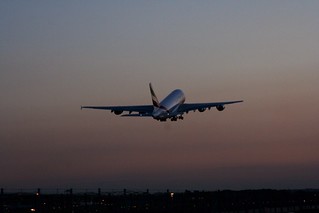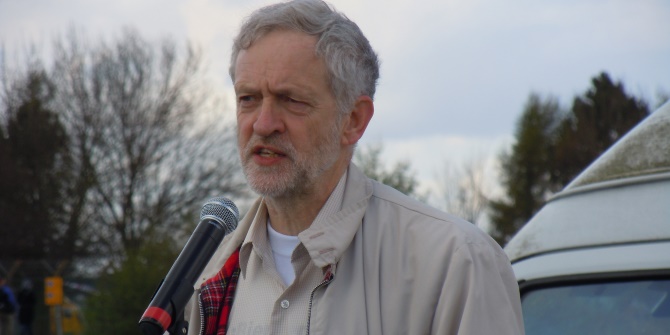 Roger Vickerman argues that there is a potential constraint on the wider economy of London which might provide a block to growth if there is no added runway capacity. There are two other options besides Heathrow, which in many ways is the easiest option: build a new airport to modern hub standards with four runways, or develop a network of regional airports in the South East as a distributed hub.
Roger Vickerman argues that there is a potential constraint on the wider economy of London which might provide a block to growth if there is no added runway capacity. There are two other options besides Heathrow, which in many ways is the easiest option: build a new airport to modern hub standards with four runways, or develop a network of regional airports in the South East as a distributed hub.

Earlier in the year both the Prime Minister and George Osborne hinted at a change in the government’s policy towards airport expansion in South East England. Before the last election all three main parties ruled out a third runway at Heathrow and any early expansion of Stansted and Gatwick. Since then Boris Johnson has been championing the case for a new airport in the Thames Estuary, dubbed Boris Island. In May Kent County Council joined the debate with its own strategy paper on aviation and the South East Local Enterprise Partnership published a consultant’s report on airport capacity in the South East. The debate was therefore re-ignited on airport expansion and particularly on the question of whether to expand existing airports or build a completely new one.
The government launched its long-awaited consultation paper on a Draft Aviation Policy Framework in July 2012 in which the foreword by the then Secretary of State Justine Greening reinforced the argument that “The main issue of contention remains airport, and particularly runway capacity”. In the September government reshuffle Greening was moved from transport and replaced by Patrick McLoughlin whose first action was to set up a commission, under the chairmanship of Sir Howard Davies, to investigate and report on the specific issue of the role of an airport hub, its contribution to the UK economy and how this relates to airport capacity. Conveniently for the government, the commission is not due to report until after the next election in 2015, although it is expected to bring forward some preliminary findings by the end of 2013.
It is clearly right that there needs to be a fundamental and informed debate on the role which aviation plays, not just in a more integrated transport policy than we have seen from any government in recent years, but in the economy as a whole. To that extent the commission is a welcome move, but it could also be seen as the classic delaying tactic when a government knows it can never command a majority for one particular policy direction. As the Policy Framework document says with reference to the various claims made about capacity: “These positions are incompatible and experience with previous proposals for a third runway at Heathrow demonstrates that without sufficient support, particularly at a political level, it would not be possible for any government to deliver new capacity, however hard some shout for it.”
At the core of the debate lies a lack of coherence and consistency in policy and lot of local politics. Airport policy has frankly been in a mess since the Roskill Commission into the Third London Airport reported in 1971. Roskill considered and rejected a Thames Estuary Airport and recommended a site at Cublington in Bedfordshire, a recommendation which was rejected by the then government in favour of Stansted. This cemented the idea of the three main airports for London (Heathrow, Gatwick and Stansted), each of which would be subject to serious constraints on development to pacify local antipathy. To some extent this policy has had the effect of spreading the misery of aircraft noise over the widest possible area without being able to maximise the advantages of a large modern hub airport in any of them. There are two arguments here: one is the argument over what capacity is needed – this involves both runway and terminal capacity; the other is where to put that capacity – can it be distributed around the country or does it require concentration in one place?
Although air traffic growth has slowed down reflecting the global economic crisis, most forecasts suggest that even with rising costs we must expect rising demand, and particularly for long-haul flights. Heathrow operates at almost full capacity almost all of the time. Minor disruptions from the weather or an incident therefore lead to escalating delays. Such disruptions cause inconvenience to travellers. When these are business travellers it has an impact on their business activities and that has an impact on the wider economy of the London region.
Low cost airlines, using secondary airports and providing only point to point travel, have enabled a lot of regional to region traffic avoiding the main hub airports and thus helping alleviate some of the capacity problems at Heathrow. But the continued growth of traffic at Heathrow shows that there is strong demand for the hub facility. At a hub airport a significant proportion of passengers are changing planes, typically between long-haul and short-haul flights. A simple view would be that these passengers are of no value to the London economy, they are simply changing planes, but the total volume of passengers passing through London determines how many planes go to how many destinations and hence how well connected London is to the rest of the world. The constraints at London means that although the number of passengers has continued to grow, the number of destinations served has not grown at the same rate and has now fallen well behind those at rival hub airports such as Paris, Amsterdam or Frankfurt according to a 2011 report for BAA by Frontier Economics. This is particularly true of destinations in the most rapidly developing parts of the world. Airlines have used the scarce slots to focus on increasing frequencies on the most profitable routes rather than developing new routes. In other words, hubbing passengers enable the greater choice which benefits those with London as an origin or destination. There is therefore a potential constraint on the wider economy of London which might provide a block to growth.
Does this expansion need all to be at Heathrow? The simple answer is no, there are two other options: build a new airport to modern hub standards with four runways, or develop a network of regional airports in the South East as a distributed hub. Expanding Heathrow is in many ways the easiest option. International companies are largely located in the wedge of the M4 and M3 to the west of London within which Heathrow sits. Heathrow is close to the proposed route of HS2, the high-speed rail line to the Midlands and North, and a direct link is more feasible to a new Terminal 6 close to the site of the proposed third runway than to the existing terminals. HS2 is not a substitute for air travel, all the evidence from around Europe is that good rail connections enhance the role of the main hub airport removing the need for domestic feeder traffic and releasing slots for more long-haul flights. However, Heathrow is in one of the most densely populated areas of any major hub airport so its environmental credentials are poor and even an expanded Heathrow would not have the long-term capacity needed for the second half of the 21st century. Arguments against Heathrow is a vote winner anywhere in those areas west of London under flight paths. But it shouldn’t be forgotten that Heathrow provides direct employment for about 76,000 people who live mainly in those areas.
Improving the connections between the South East region’s airports would utilise the existing runways and terminal capacity. Though even with high-speed rail links between them, which would be more intrusive and more destructive of the environment than expanding an existing airport, a network of airports could not fulfill all the functions of a major hub. It would increase passenger transfer times and increase airlines’ costs. The danger is that the separate airports just become feeder airports for hubs in Paris, Amsterdam etc. and not seen as part of a network.
Proposals for a new airport in the Thames Estuary have been around since 1945 and various sites were closely examined during the Roskill Commission Inquiry more than 40 years ago. The major objections to this, other than the one that no-one really wants to have a major international airport placed next door, are environmental (destruction of valuable habitats), safety-related (particularly the incidence of bird strikes) and air traffic related (the new airport would interfere with approaches to all other airports in the South East and possibly Schiphol).
Perhaps the biggest hurdle has been that planning in the UK has always been incremental, taking a major step such as relocating the country’s main airport has been seen as a step too far, too expensive, too long-term. But suppose that such an airport had been developed even 40 years ago would we not now take it for granted? Remember, it took 186 years to complete the Channel Tunnel and that is now very clearly just part of the furniture. This may have to be the real long-term solution, but that leaves the short to medium term problem and it may be that only an expanded Heathrow can solve this. In the meantime whilst we wait for the Davies Commission to report and allow the local interest politicking to gain momentum the whole UK economy, not just London, will face increasing problems and more and more of us will turn to hubs outside the UK. Delay does not always mean choosing the right solution and it may also not avoid some increasingly vitriolic political arguments.
Note: This article gives the views of the authors, and not the position of the British Politics and Policy blog, nor of the London School of Economics. Please read our comments policy before posting.
Roger Vickerman is Dean of the University of Kent’s, Brussels Campus. He is also Professor of European Economics at the University of Kent and Director of the Centre for European, Regional and Transport Economics.






